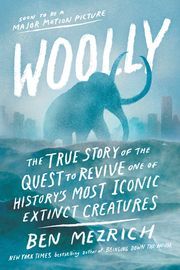Woolley Bully

Just as the gap between reality and satire has narrowed recently, scientists are hard at work trying to eclipse science fiction. Step aside "Jurassic Park," make way for the new and improved woolly mammoth, vast herds of which will roam the Arctic tundra as in millennia past.
At least, so predicts best-selling author Ben Mezrich. His latest book is “soon to be a major motion picture,” according to its cover.
"Woolly: The True Story of the Quest to Revive One of History’s Most Iconic Extinct Creatures" spins this yarn of genetic creationism and scientific derring-do with breathless prose, which in places is indistinguishable from dust jacket fare. The reader will be forgiven for thinking that these big-tusked behemoths will reappear at the same time as the movie premiere. (Fox bought the film rights.)
The hero of this tale is Harvard professor and geneticist Dr. George M. Church, a Dudley Do-Right of high science who wants to use rapidly advancing biotechnologies to eradicate Lyme disease in humans, herpes in Asian elephants, and other scourges.
Lesser characters in this brave new world include Stewart Brand, who published the Whole Earth Catalog, and Peter Thiel, of PayPal fame, who is funding efforts to find the Fountain of Youth. Without a touch of irony, Mezrich (author of "The Accidental Billionaires") terms Thiel’s "passionate belief" in using science to attain a “massively extended life span” as “infectious.”
Long live us, but with so many existing species endangered or going extinct, why would anyone want to bring back the woolly mammoth? The rationale, thin as it is, goes like this: grazing mammoths once kept the Arctic tundra grassy and cooler and can do so again if allowed to tromp about on the top of our warming planet.
Mezrich writes that Russian researchers have verified this theory using modern ungulates such as elk. As matters now stand, scientists worry that the release of methane gas from melting permafrost will transform gradual global warming into a planetary barbecue.
Near the very end of the book, Brand chimes in with a chapter all his own in which he undermines the very premise that he and Mezrich are pushing: that mammoths can ride to the rescue of Mother Earth. He writes that restoring these tuskers to the wild “will take many decades, probably most of this century.” By then, the die likely will be cast.
The honor of writing the epilogue went to Dr. Church himself, whose peripatetic prose is challenging, to put it mildly. Here’s a sample, from his rumination on whether pigs can be made to fly:
“The largest flying animal ever was Quetzalcoatlus northropi at 200 kg. It is estimated to have been able to fly for ten days at an altitude of 4.5 km and speed of 129 km/hr. While a conventional pig can get up to 300 kg, the smallest adult mini-pig is 25 kg. So, plenty of room between the 25 kg minimum for pigs and the 200 kg maximum for flight. Bat morphogenetic pathways could be moved over to the pig…to elongate their arms…”
His conclusion appears to be “yes.” The day “when pigs fly” is nearer at hand than generally believed.